Law enforcement in France
Law enforcement in France has a long history dating back to AD 570 when night watch systems were commonplace.[1] Policing is centralized at the national level.[1] Recently, legislation has allowed local governments to hire their own police officers which are called the "police municipale".[1]


There are two national police forces called "Police nationale" and "Gendarmerie nationale". The Prefecture of Police of Paris provides policing services directly to Paris as a subdivision of France's Ministry of the Interior. Within these national forces, only certain designated police officers have the power to conduct criminal investigations which are supervised by investigative magistrates.
Organizations
National agencies
France has two national police forces:[1]
- The Police Nationale, formerly called the "Sûreté", is considered a civilian police force. Its origins date back to 1812 and was created by Eugène François Vidocq. In 1966, its name was officially changed to "Police Nationale".[1] It has primary responsibility for major cities and large urban areas. The Police Nationale are under the control of the Ministry of the Interior; its strength is roughly 150,000.[1]
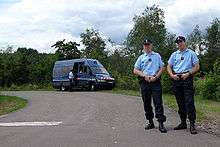
- The Gendarmerie Nationale is part of the French armed forces. It has the primary responsibility for policing smaller towns and rural areas as well as the armed forces and military installations, airport security and shipping ports. Being a military force, the gendarmerie has a highly centralized organization structure. It is under the control of both the Ministry of Defence and the Ministry of the Interior (as far as its civil duties are concerned).[1] The Gendarmerie's origin dates back to 1306 when King Philippe le Bel (Philip the Fair) formed the first mounted military police force called the "Maréchaussée".[1] Between 1697 and 1699, King Louis XIV asserted his authority over police in France and the Maréchaussée became the formal law enforcement arm of the country.[1] In February 1791, it was renamed gendarmerie nationale by the revolutionary government of France.[1] Today, there are about 105,000 gendarmes in France.[1]
Other agencies
National level
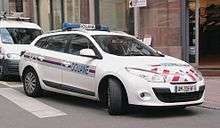
- Direction générale des douanes et droits indirects, a nowadays civilian customs service more commonly known as the "Douane", under the minister of budget, public accounting and civil servants; its strength is roughly 17,000. It operates mainly on a different framework of the other agencies;
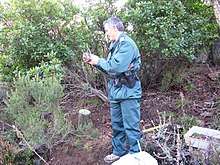
- National Forests Office and other State environmental agencies are the continuation of the Water and Forests military corp founded in 1291 and today under both the Ministry of environment and the Ministry of Agriculture. They have special environment law enforcement and police power that ranges from pollution, hunting, fishing, forests products to nature protection. Its strength was roughly 10,000 in 2007, only counting the National Forests Office;
- Corps of Prison Administration Supervisory Personnel, created by a decree of April 14, 2006. The missions of prison guards are to ensure the execution of sentences, to help ensure the integration or reintegration of detained persons, to ensure public security while respecting the interests of society, the rights of victims and the rights of detained persons.
Local level

The municipal policemen can notice all the breaches but cannot investigate. There are also local police in the rural zones, as for the rural policemen the police rurale as such does not exist. Note the heterogeneity of local police both in means and in equipment.
- Police municipale are the local police of towns and cities in France. The French municipal police are under the direct authority of the mayor and may or may not be armed according to the local mayor's discretion.
- The municipal police of Paris is the Paris Police Prefecture, a branch of the Police Nationale
- Rural communes may also form a garde champêtre which is responsible for limited local patrol and protecting the environment.
- In Wallis and Futuna, there is a territorial guard as well as royal police.
Police and gendarmerie
The leadership of both agencies is centralized and they both have conventional deviance control responsibilities respectively except in different geographical locations in France.[1] The Police Nationale is responsible for Paris and other urban areas whereas the gendarmerie is responsible for small towns and rural areas with fewer than 20,000 inhabitants.[2] The existence of two national police forces with similar goals and attributions, but somewhat different zones of activity, has at times created friction or competition between the two. Their merging has sometimes been suggested.
With the development of suburban dwellings, this had increasingly proved inadequate. Furthermore, the shifting of a town from a police to a gendarmerie zone was often controversial, because, typically, a gendarmerie unit serves a wide area.[3]
A redistribution of authority was thus decided and implemented between 2003 and 2005. Large conurbations are now handled entirely by the police. Rural and suburban areas, and some smaller cities with populations ranging from 5,000 to 16,000, are handled by the gendarmerie.[3]
In addition, the police and the gendarmerie have specific zones of authority:
- the police handle questions about the admittance, monitoring and continuing stay of foreigners (border police);
- the gendarmerie handle all matters regarding the military, the police at sea, the security of airports, and the security of certain public buildings (Republican Guard).
French police jurisdictions
In French, the term police not only refers to the forces, but also to the general concept of "maintenance of law and order" (policing).
There are two types of police in this general sense:
- administrative police (police administrative), upholding public order, safety checks and traffic controls, assistance to people in imminent danger, protection duties, etc.
- judicial police (police judiciaire), handling penal law enforcement and investigation of crimes and felonies under the authority of a Magistrate (Procureur de la République) in every case.
Also, the mayor (le maire) has administrative police power in a commune (municipality), which means that he or she can order the police to enforce municipal bylaws.
A judge has police power in his courtroom (i.e. he or she can order people who disrupt the trial to be expelled from the proceedings).
Until 1984, the National Police were involved in prehospital rescue operations and casualty transport (called police-secours). Prehospital aid is now performed by fire services; however, mountain rescue is shared between the gendarmerie's PGHM (pelotons de gendarmerie de haute montagne, High Mountain Platoons of the Gendarmerie) and the National Police's CRS (compagnies républicaines de sécurité; Republican [national] security companies).
Many other countries have followed the French model and have established separate police agencies with the same role but different jurisdictions.
A local precinct of the "police nationale" (called commissariat) or the "gendarmerie nationale" (called brigade) may not be capable of conducting complex investigations. For this reason, both the police and the gendarmerie maintain regional services dedicated to criminal investigations (police judiciaire); these are known as "regional services of judiciary police" (Services régionaux de la Police judiciaire) in the police, "research sections" (Sections de recherche de la Gendarmerie nationale) in the gendarmerie. In addition, both the police and the gendarmerie maintain laboratories dedicated to forensics. The forensics service of the police is called Police technique et scientifique (Technical and Scientific Police). It is the equivalent of the American CSI Units.
Most criminal enquiries are conducted by the police. Justice may choose either service; sometimes, if the judiciary is disappointed by the results or the methods of one service, it may give the enquiry to the other service.
The National Police also features some central offices with national jurisdiction, charged with specific missions, such as the national anti-terrorist division.
Both the police and the gendarmerie have police tactical units. The gendarmerie has the foremost and best-known, the GIGN; the police have the RAID and the BRI groups. The gendarmerie also has armoured and paratroop squadrons.
Both the police and the gendarmerie have crowd and riot control forces: the CRS (Compagnies Républicaines de Sécurité) for the police, the gendarmerie mobile for the gendarmerie. They intervene throughout the country.
One reason for giving commission to a military force to handle matters of civilian police is that the military is not allowed to go on strike, contrary to civilian public servants such as the police personnel, which enables the government to always have an instrument of law enforcement at hand.
Another advantage of the gendarmerie is that, being career soldiers, they have the authority to use armed force in a much less restricted way than the police (in popular culture so-called licence to kill).
The gendarmes have free housing facilities inside their respective gendarmerie brigades (precincts) or live in barracks (casernes), which is not the case for the police.
Procedures
Administrative police
The police administrative comprises a variety of actions undertaken under the direction and supervision of the executive branch, notably the prefect, police and gendarmerie forces conduct a variety of actions ensuring public order. They include:
- directing road traffic
- channelling street demonstrations
- positioning riot control forces (CRS or mobile gendarmerie)
Judicial police
The police judiciaire comprise a variety of actions undertaken under the direction and supervision of the judiciary. They include:
- pursuing and arresting suspects
- interrogating suspects in some phases of judicial enquiries
- gathering evidence
- serving search warrants
These actions must follow the rules given in the Code of Penal Procedure (Code de procédure pénale), articles 12 to 29.
In order to better fulfill these missions, the Direction Centrale de la Police Judiciaire of the French National Police regroups all the units specialized in criminal enquiries. The gendarmerie counterpart are the sections de recherche (research sections).
Rights and limitations
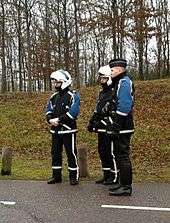
The powers of French police and gendarmerie forces are constrained by statute law. The rules of procedure depend on the stage of enquiry:
- Crimes committed in flagrante delicto, in which a suspect was found committing the crime, or pursued by witnesses, or found in possession of objects from the crime or other probable cause.
- Preliminary enquiries: it is unclear whether a crime, or which crime, has been committed, but there exist good reasons to believe this might be the case.
- Judicial information: an investigative magistrate (a judge, external to the police) supervises an inquiry on a case where it is certain, or at least very probable, that a crime has been committed.
In particular, except for crimes in flagrante delicto, law enforcement forces may not conduct searches or arrests without a specific commission from the investigative magistrate. Depending on legal status of cases, not all law enforcement officers are able to act; some powers are restricted to those with special legal qualifications (see next section).
Officers and agents of judiciary police
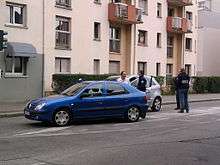
The procedures that police and gendarmerie officers follow when conducting criminal inquiries are set by the code of criminal procedure (Code de procédure pénale) and applicable jurisprudence. Criminal inquiries are conducted under the supervision of the judiciary (depending on the phase, under the supervision of the public prosecutor or of an investigative judge).
There are three judiciary qualifications: "officer of judiciary police" (officier de police judiciaire or OPJ), "agent of judiciary police" (agent de police judiciaire or APJ) and "agent of judiciary police assistant" (APJ adjoint). The qualifications of OPJ and APJ can only be exercised if they are affected to a position where these are needed, and, for the OPJs by nominal decision of the general prosecutor of their area. These prerogatives are temporarily suspended when they engage, in an organized force, in an operation of public order (i.e. riot control).
- Mayors and deputy mayors are OPJs. This disposition is rarely used.
- In the National Police, these are qualified as OPJs:
- the commissionners and above ranks;
- the titular members of the corps de commandement nominally listed in a joint decision by the ministers of justice and of the interior;
- members of the Corps d'encadrement et d'application who have completed three years of service, and are nominally listed in a joint decision by the ministers of justice and of the interior.
- In the National Gendarmerie, these are qualified as OPJs:
- commissioned officers
- non-commissioned officers having completed three years of service, nominally designated by a joint decision by the ministers of justice and of defense.
These ministerial nomination decisions may only be taken after the approval of a specific commission. The current rules also warrant the completion of an examination pertaining to legal matters.
Most other members of the National Police and gendarmerie are APJs. The remaining members of the National Police, as well as members of municipal police forces, are APJ assistants.
Only OPJs may serve search (this includes anybody search more invasive than external palpation) and put somebody in custody ("garde à vue") for 24 hours; APJs may only assist them in these tasks. In case a suspect has been apprehended by an APJ, he or she must be brought before an OPJ which will in turn have to inform the public prosecutor. According to the law, any citizen can apprehend the author of a crime or of an offense that can be punished by a prison sentence (citizen's arrest) and lead him or her to an OPJ. However, this is problematic in case of a "simple" citizen due to the estimation of what can be punished by a prison sentence or not, and due to possible abuse (abuses are a restriction of individual freedom and can be sued for illegal confinement).
The quality of officer of judiciary police may be withdrawn by the judiciary if the officer has behaved in an inappropriate fashion. The general prosecutor grades OPJs and these grades are taken into account for possible promotions.
Comparative ranks of French police services
| # | Police nationale | Gendarmerie nationale | Police municipale | Police rurale |
|---|---|---|---|---|
| 1. | Directeur général de la police nationale | Général d'armée | — | — |
| 2. | Directeur des Services Actifs | Général de corps d'armée | — | — |
| 3. | Inspecteur Général | Général de division | — | — |
| 4. | Contrôleur Général | Général de brigade | — | — |
| Commissaire général de Police | ||||
| 5. | Commissaire Divisionnaire de Police | Colonel | — | — |
| 6. | Commissaire de Police | Lieutenant-colonel Chef d'escadron | — | — |
| 7. | Commandant de Police | Chef d'escadron | Directeur principal de police municipal | — |
| Directeur de police municipale | ||||
| 8. | Capitaine de Police | Capitaine | Chef de service principal de 1re classe | — |
| 9. | Lieutenant de Police | Lieutenant | Chef de service principal de 2e classe | — |
| 10. | — | Sous-lieutenant | Chef de service | — |
| 12. | Brigadier-Major de Police | Major | Chef de police municipale | — |
| 13. | Brigadier-Chef de Police | Adjudant chef | Brigadier Chef Principal | — |
| 14. | Brigadier de Police | Adjudant | Brigadier de Police | Garde Champêtre Chef Principal |
| 15. | Sous-Brigadier | Maréchal des logis-chef | Gardien de la Paix Principale | Garde Champêtre Chef |
| 16. | Gardien de la Paix | Gendarme | Gardien de la Paix | Garde Champêtre Principal |
Transportation
Police Nationale
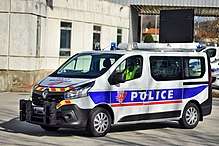
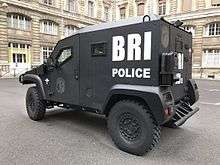
- BMW R1100RT
- Citroën Berlingo
- Citroën C8
- Citroën Evasion
- Citroën Jumper
- Citroën Xsara
- Citroën ZX[4]
- Dacia Duster
- Ford Focus
- Ford Galaxy
- Ford Transit
- Iveco Daily
- Land Rover Defender
- Nexter Titus[5]
- Panhard PVP[6]
- Peugeot 306
- Peugeot 307
- Peugeot 308
- Peugeot Expert
- Renault Espace
- Renault Kangoo
- Renault Mascott
- Renault Master
- Renault Scénic
- Renault Trafic
- Renault Twingo[7]
- Yamaha FJR1300
Gendarmerie Nationale
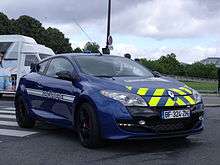
- Alpine A310
- Berliet VXB-170
- BMW R1100RT
- Citroën C4
- Citroën C8
- Citroën SM
- Citroën Berlingo
- Dacia Duster
- Ford Focus
- Ford Galaxy
- Ford Transit
- Iveco Daily
- Land Rover Defender
- Mercedes-Benz Vito
- Nissan NP300
- Peugeot 206
- Peugeot 306
- Peugeot 308
- Peugeot Expert
- Peugeot Partner
- Peugeot P4
- Renault B.90
- Renault Clio
- Renault Kangoo
- Renault Master
- Renault Mégane
- Renault Mégane RS
- Renault Trafic
- Renault TRM 2000
- Renault B 110
- Subaru Impreza
- Skoda Kodiaq
- Yamaha FJR1300
- Yamaha MT-09
- Yamaha TDM
See also
References
- Dammer, H. R. and Albanese, J. S. (2014). Comparative Criminal Justice Systems (5th ed.). Wadesworth Cengage learning: Belmont, CA. ISBN 978-1-285-06786-5
- Weisheit, Ralph (23 August 2015). Pursuing Justice: Traditional and Contemporary Issues in Our Communities and the World (2 ed.). Anderson Publishing. p. 66. ISBN 978-0-323-29459-1.
- "Premier-ministre.gouv.fr". Archived from the original on 7 April 2005. Retrieved 11 March 2005.
- "Citroën ZX Break Police Nationale". Skyrock. 2 December 2005.
- "Le Titus, un blindé de 20 tonnes, est en test à la préfecture de police de Paris". France Bleu. 5 May 2016.
- "Gsg9 1/87 Unité spéciale: Véhicules d'intervention du Raid, BRI, GIGN, Police Française". 7 May 2016.
- "Renault Twingo Police - Guide Automobiles Anciennes". www.guide-automobiles-anciennes.com.
External links
- (in French) Legal analysis of the goals of administrative policing
- (in French) Code of penal procedure
- (in French) Direction centrale de la police judiciaire, Aspects de la criminalité et de la délinquance constatées en France en 2004 par les services de police et les unités de gendarmerie, vol 1, vol 2 (PDF); to be published by La Documentation française
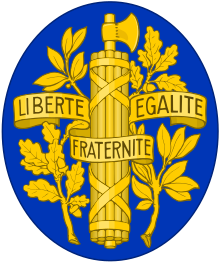
.svg.png)